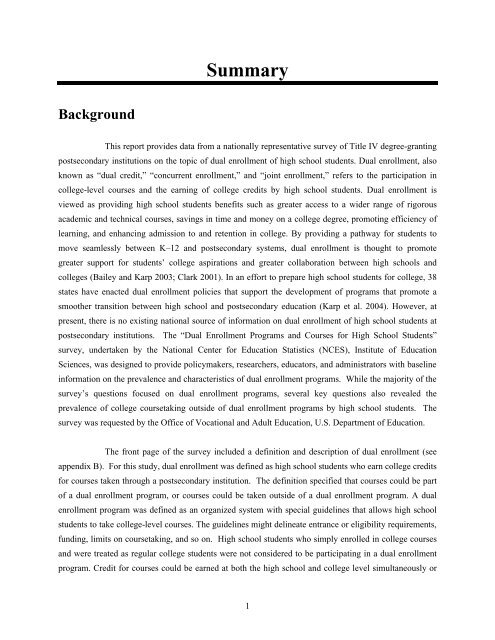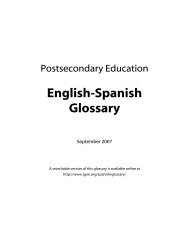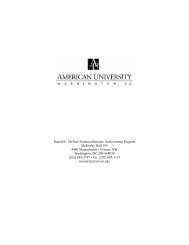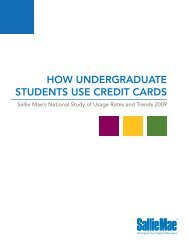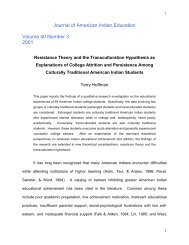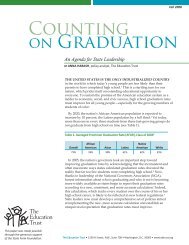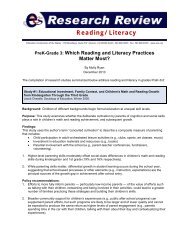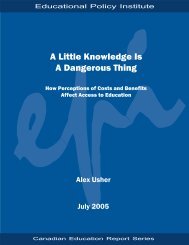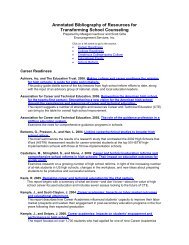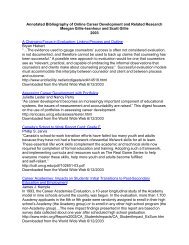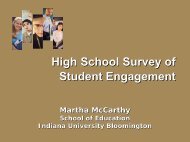Dual Enrollment of High School Students at Postsecondary Institutions
Dual Enrollment of High School Students at Postsecondary Institutions
Dual Enrollment of High School Students at Postsecondary Institutions
You also want an ePaper? Increase the reach of your titles
YUMPU automatically turns print PDFs into web optimized ePapers that Google loves.
Summary<br />
Background<br />
This report provides d<strong>at</strong>a from a n<strong>at</strong>ionally represent<strong>at</strong>ive survey <strong>of</strong> Title IV degree-granting<br />
postsecondary institutions on the topic <strong>of</strong> dual enrollment <strong>of</strong> high school students. <strong>Dual</strong> enrollment, also<br />
known as “dual credit,” “concurrent enrollment,” and “joint enrollment,” refers to the particip<strong>at</strong>ion in<br />
college-level courses and the earning <strong>of</strong> college credits by high school students. <strong>Dual</strong> enrollment is<br />
viewed as providing high school students benefits such as gre<strong>at</strong>er access to a wider range <strong>of</strong> rigorous<br />
academic and technical courses, savings in time and money on a college degree, promoting efficiency <strong>of</strong><br />
learning, and enhancing admission to and retention in college. By providing a p<strong>at</strong>hway for students to<br />
move seamlessly between K–12 and postsecondary systems, dual enrollment is thought to promote<br />
gre<strong>at</strong>er support for students’ college aspir<strong>at</strong>ions and gre<strong>at</strong>er collabor<strong>at</strong>ion between high schools and<br />
colleges (Bailey and Karp 2003; Clark 2001). In an effort to prepare high school students for college, 38<br />
st<strong>at</strong>es have enacted dual enrollment policies th<strong>at</strong> support the development <strong>of</strong> programs th<strong>at</strong> promote a<br />
smoother transition between high school and postsecondary educ<strong>at</strong>ion (Karp et al. 2004). However, <strong>at</strong><br />
present, there is no existing n<strong>at</strong>ional source <strong>of</strong> inform<strong>at</strong>ion on dual enrollment <strong>of</strong> high school students <strong>at</strong><br />
postsecondary institutions. The “<strong>Dual</strong> <strong>Enrollment</strong> Programs and Courses for <strong>High</strong> <strong>School</strong> <strong>Students</strong>”<br />
survey, undertaken by the N<strong>at</strong>ional Center for Educ<strong>at</strong>ion St<strong>at</strong>istics (NCES), Institute <strong>of</strong> Educ<strong>at</strong>ion<br />
Sciences, was designed to provide policymakers, researchers, educ<strong>at</strong>ors, and administr<strong>at</strong>ors with baseline<br />
inform<strong>at</strong>ion on the prevalence and characteristics <strong>of</strong> dual enrollment programs. While the majority <strong>of</strong> the<br />
survey’s questions focused on dual enrollment programs, several key questions also revealed the<br />
prevalence <strong>of</strong> college coursetaking outside <strong>of</strong> dual enrollment programs by high school students. The<br />
survey was requested by the Office <strong>of</strong> Voc<strong>at</strong>ional and Adult Educ<strong>at</strong>ion, U.S. Department <strong>of</strong> Educ<strong>at</strong>ion.<br />
The front page <strong>of</strong> the survey included a definition and description <strong>of</strong> dual enrollment (see<br />
appendix B). For this study, dual enrollment was defined as high school students who earn college credits<br />
for courses taken through a postsecondary institution. The definition specified th<strong>at</strong> courses could be part<br />
<strong>of</strong> a dual enrollment program, or courses could be taken outside <strong>of</strong> a dual enrollment program. A dual<br />
enrollment program was defined as an organized system with special guidelines th<strong>at</strong> allows high school<br />
students to take college-level courses. The guidelines might deline<strong>at</strong>e entrance or eligibility requirements,<br />
funding, limits on coursetaking, and so on. <strong>High</strong> school students who simply enrolled in college courses<br />
and were tre<strong>at</strong>ed as regular college students were not considered to be particip<strong>at</strong>ing in a dual enrollment<br />
program. Credit for courses could be earned <strong>at</strong> both the high school and college level simultaneously or<br />
1


